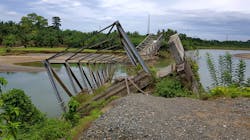Congress again kicks infrastructure vote down the crumbling road
Time is a flat circle covered with potholes.
The House of Representatives, once again last Thursday, ditched plans to vote on the Senate’s $1 trillion bipartisan infrastructure bill as progressive Democrats quibbled over how much to spend on social initiatives and which ones to prioritize.
Ten months after taking office with lofty goals to unite a fractured nation and fix its crumbling roads and bridges, it might take an act of God just to unite President Biden’s own party. He attempted to do just that before flying to Europe to meet with the Pope ahead of the G20 summit in Rome.
The 2,700-page infrastructure bill, passed this summer by the Senate, has been held up by House progressives more focused on social spending. Each time Speaker Nancy Pelosi has set a deadline for her chamber to vote, the bill has failed to make its way to the House floor.
It appeared last week the president and congressional Democrats found enough common ground to support a $1.75 trillion plan focused on climate measures, free preschool, expanded health care, and more. But plans to vote on either package were put off until another day.
That revised “social infrastructure” spending is less than what the more progressive members of Congress were pushing for in a narrowly divided legislature that needs moderates’ support to get anything passed in the Senate. While the Congressional Progressive Caucus appeared ready to back a deal worth nearly $2 trillion less than it first proposed, the group forced Pelosi, once again, to scrap plans for the House to vote on the “hard infrastructure” vote.
After a closed-door meeting at the Capitol on Thursday, Biden said they “have a historic economic framework" to pass both packages. “I don’t think it’s hyperbole to say that the House and Senate majorities and my presidency will be determined by what happens in the next week,” he said in the meeting, according to the Washington Post.
When Congress votes on the spending packages is still not known. But progressives signaled that they would accept the watered-down social spending—while asking for time to review the legislation. The president is scheduled to return stateside on Wednesday, Nov. 3.
“Our country and industry depend on” the bipartisan infrastructure bill, P. Sean Garney, co-director of Scopelitis Transportation Consulting, told FleetOwner recently. “Our supply chain is under intense pressure, our roads are falling apart, and crashes are on the rise. It’s not if; it’s when. We’ll just all need to live through the brinksmanship and grandstanding until a mounting crisis clears the way. It’s not the way it’s supposed to work, but it, unfortunately, is the way things work in D.C. these days.”
The trucking industry has been pushing for more infrastructure spending for years—something the three previous presidents of the 21st century have been unable to deliver. If the bipartisan infrastructure bill, which found support from moderate Republicans in the Senate, does pass, it would be the most significant federal spending package on roads and bridges this century.
More than 8 million Americans work in the trucking industry, which moves more than 70% of the nation’s freight along U.S. roads. “Our industry, our drivers, they see firsthand the dire conditions of our roads and bridges,” Chris Spear, American Trucking Associations’ president and CEO, said in late September—just before the House pushed off a previously scheduled vote on the bill. “This is our shop floor. And we’re making sure that those store shelves are restocked and that the PPE and now the vaccines are delivered throughout the country.”
Spear said that the more than 3.5 million truck drivers moving that freight deal with the nation’s crumbling infrastructure every day. “Of the 617,000 bridges across the U.S., nearly half of those are 50 years old,” he said. “And 46,000 of them are structurally deficient. Of our 4 million miles of public roads, nearly half are in poor or mediocre condition. This is embarrassing—and it’s completely unacceptable.”
There is a lot to do with trucking in the 2,700-page infrastructure bill: a mandate for automatic emergency braking (AEB) systems on commercial vehicles, trailer and truck underride guard studies, driver workforce outreach programs, promoting women to work in the trucking industry, a study of truck leasing, a pilot program to allow younger drivers to operate across state lines, among other items.
This story originally appeared on FleetOwner.
About the Author

Josh Fisher
Technology Editor
FleetOwner Editor-in-Chief Josh Fisher has been with Endeavor's Commercial Vehicle Group since 2017, covering everything from modern fleet management to operational efficiency, artificial intelligence, autonomous trucking, regulations, and emerging transportation technology. He is based in Maryland.
